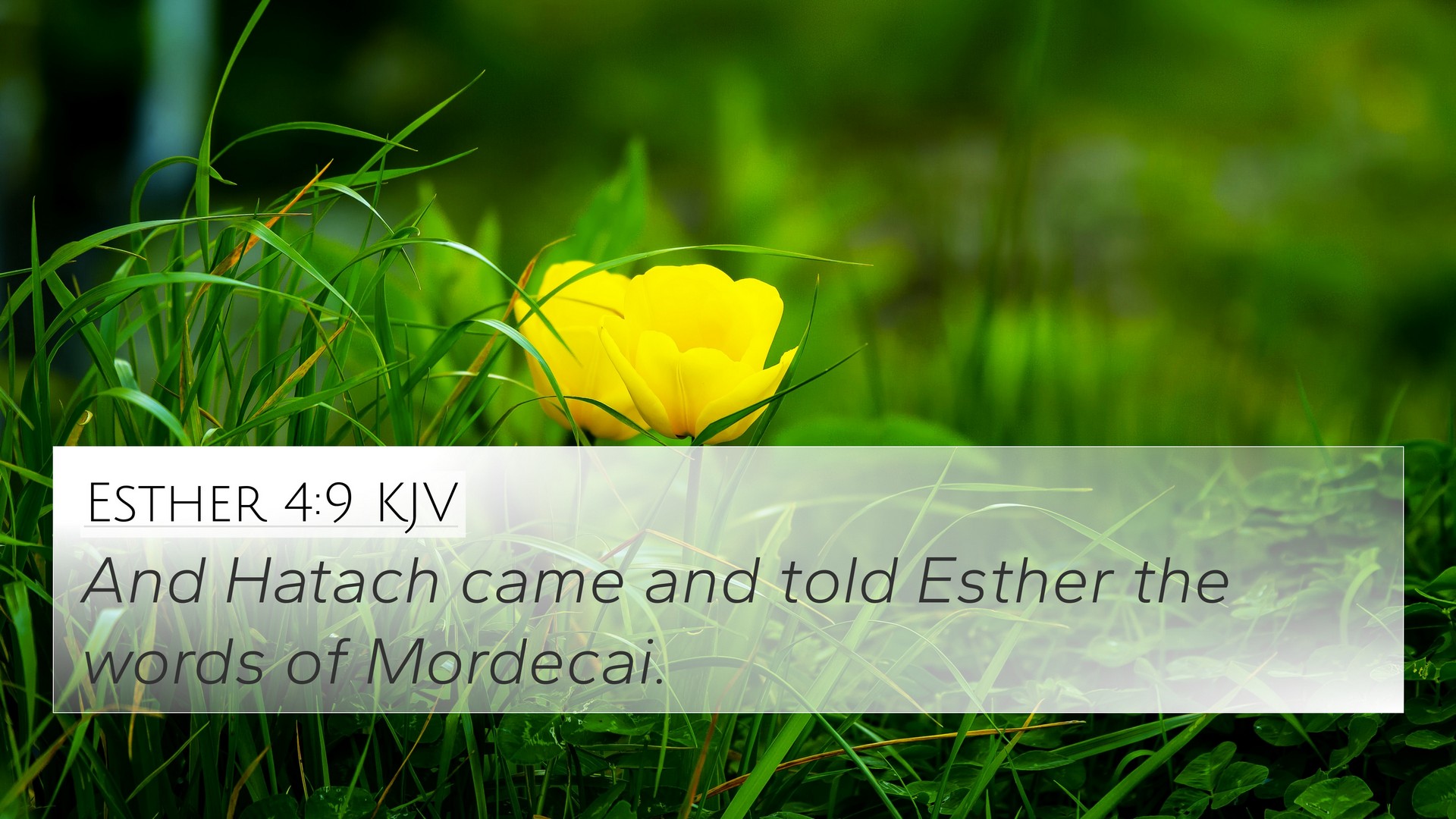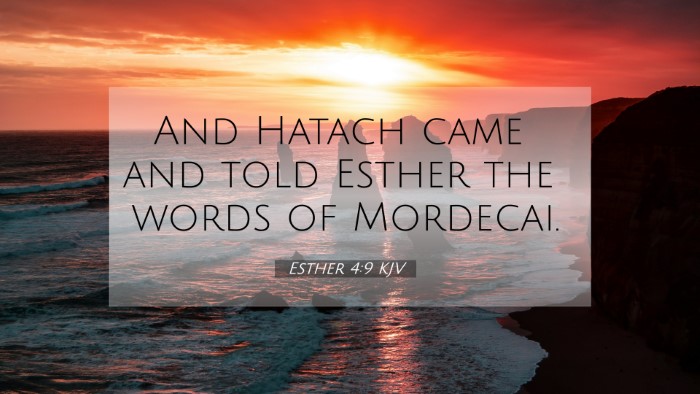Old Testament
Genesis Exodus Leviticus Numbers Deuteronomy Joshua Judges Ruth 1 Samuel 2 Samuel 1 Kings 2 Kings 1 Chronicles 2 Chronicles Ezra Nehemiah Esther Job Psalms Proverbs Ecclesiastes Song of Solomon Isaiah Jeremiah Lamentations Ezekiel Daniel Hosea Joel Amos Obadiah Jonah Micah Nahum Habakkuk Zephaniah Haggai Zechariah MalachiEsther 4:9 Similar Verses
Esther 4:9 Cross References
And Hatach came and told Esther the words of Mordecai.
Uncover the Rich Themes and Topics of This Bible Verse
Listed below are the Bible themes associated with Esther 4:9. We invite you to explore each theme to gain deeper insights into the Scriptures.
Esther 4:9 Cross Reference Verses
No cross reference images were found in our system for this Bible passage.
Esther 4:9 Verse Analysis and Similar Verses
Meaning and Interpretation of Esther 4:9
Esther 4:9 states: "And Hatach came and told Esther the words of Mordecai." This verse highlights the pivotal role of communication in the unfolding drama of the Book of Esther, where the fate of the Jewish people hangs in the balance.
Summary of Insights
This verse underscores several critical themes within the narrative and serves as a conduit for understanding Esther's eventual actions. The commentaries from Matthew Henry, Albert Barnes, and Adam Clarke provide valuable insights into its meaning.
-
Importance of Communication:
Hatach, as a messenger, plays a crucial part in facilitating the dialogue between Mordecai and Esther. Esther is in a position to influence the king, and the knowledge Mordecai imparts is essential for her to act effectively.
-
Role of Esther:
Esther's hesitance to engage in the matter suggests the gravity of the situation. She is initially hesitant because approaching the king without being summoned could result in death. This reflects the perilous circumstances they face as a community.
-
Divine Providence:
The positioning of Hatach echoes the theme of divine providence throughout the book, suggesting that God orchestrates events to protect His people, even when His name is not directly mentioned in the text.
-
Symbol of Loyalty:
The relationship between Mordecai and Esther reveals loyalty and courage. Mordecai seeks to protect his people and encourages Esther to embrace her identity and responsibilities. Their connection exemplifies the bonds that unite them in the face of adversity.
Cross-References to Esther 4:9
Understanding Esther 4:9 in light of other Scripture enhances its interpretation. Here are key cross-references:
- Esther 2:10: Esther’s identity and background as a Jew highlight the significance of her role.
- Esther 3:12: The decree to annihilate the Jews sets the stage for the urgent communication between Mordecai and Esther.
- Esther 4:14: Mordecai’s pivotal message about Esther's potential purpose reinforces her responsibility.
- Esther 7:2: The eventual confrontation with the king shows the outcome of the decisions made based on communication.
- Proverbs 15:22: “Without counsel plans fail, but with many advisers, they succeed.” This reflects the dynamics of seeking wisdom.
- Philippians 4:6-7: Supports the idea of discussing urgent matters and seeking prayerful guidance in crises.
- Isaiah 41:10: “Fear not, for I am with you.” This gives a sense of comfort in times of uncertainty for Esther and the Jews.
- Psalm 46:1: The assurance of God as a refuge and strength resonates deeply within this narrative.
- Romans 8:28: Highlights that God can work all things together for good, reflecting on Esther's ultimate decisions.
- Matthew 10:16: “Behold, I am sending you out as sheep in the midst of wolves…” illustrates courage in facing perilous situations akin to Esther's.
Connecting the Themes
The themes of courage, identity, and divine guidance resonate throughout these connections between Bible verses. By examining Esther 4:9 alongside these other passages, we can understand:
- Human Responses: How characters in the narrative react to the challenges they face draws parallels to personal faith journeys.
- God's Sovereignty: The way God’s providence plays out through human actions, seen in Esther's initial reluctance transformed into bravery.
- Community and Responsibility: The interplay between individual roles and collective destiny emphasizes the need for action in times of crisis.
Tools for Further Study
For those interested in delving deeper into cross-referencing Bible verses, the following tools and methods can enhance your study:
- Bible Concordance: A comprehensive tool to locate words and themes throughout Scripture.
- Cross-Reference Bible Study Guides: These guides facilitate deeper analysis and thematic connections among verses.
- Bible Reference Resources: Leverage resources that provide guidance on linking scripture to discover overarching themes.
- Cross-Referencing Bible Study Methods: Explore various methods that allow for thematic biblical analysis.
- Bible Chain References: Utilize interrelated verses to create chains of understanding across the Scriptures.
Conclusion
In conclusion, Esther 4:9 serves as a powerful reminder of the importance of communication, the roles individuals play within God's plan, and the overarching themes of courage and divine providence. Reflecting on the insights from various commentaries, cross-referencing with other verses, and utilizing available study tools can deepen comprehension and application of this essential Biblical episode.


